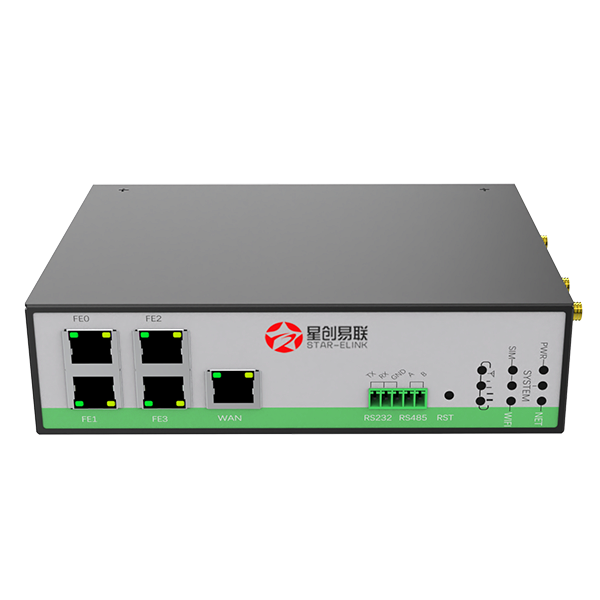SEARCH
— 葡萄酒 | 威士忌 | 白兰地 | 啤酒 —
— 葡萄酒 | 威士忌 | 白兰地 | 啤酒 —

The SR700 product is an IoT wireless router product that integrates 4G/5G networks, virtual private networks, and other technologies. Leveraging 4G/5G wireless wide area network and Wi-Fi wireless local area network technologies, this device provides uninterrupted access to various networks. With its comprehensive security and wireless service features, it offers users a high-speed and stable data transmission channel.
Supports 5 Ethernet ports
Supports WLAN (optional)
Supports wired and wireless backup
Supports rail and desktop installation
Supports dual-operator network backup (dual SIM cards)
Supports efficient completion of large-scale device network deployment
Industrialized design, capable of withstanding challenging conditions
Supports 4G LTE CAT4 high-speed network, optional 1.8GHz private network
Supports Linux OpenWrt system, facilitating user secondary development, and providing comprehensive secondary development guidelines
Supports various VPN functions: PPTP, L2TP, IPSEC, OPENVPN, GRE, GRETAP, Vxlan, etc
Supports SNMP and StarLink STAR DEVICE MANAGER StarCloud platform, enabling efficient remote centralized network management
| Technical Parameters | |
| Memory | 128MB |
| FLASH | 16MB |
| WIFI (optional) | 2.4G supports 802.11b/g/n, with a maximum speed of 150Mbps |
| Network support | Industrial-grade 4G module, supporting seven-mode networks |
| System time | Time synchronization using NTP technology, with built-in RTC |
| Interfaces | |
| WAN port | 1 WAN port |
| LAN port | 4 ports (10M/100M/1000M adaptive MDI/MDIX port) |
| SIM card interface | 2 slots (drawer-type card slot, supporting 1.8V/3V SIM/UIM cards) |
| Reset | 1 (reset button) |
| Antenna interface | 2 ports (3G/4G antenna, 50-ohm impedance, SMA female inner hole interface) |
| 1 port (2.4G antenna, 50-ohm impedance, SMA inner pin interface) | |
| Power terminal | 1 terminal (2-pin 3.81mm pitch connector) |
| Console port | 1 port. |
| Indicators | 9 (1 PWR indicator, 1 SYS indicator, 3 signal strength indicators, sim1, sim2, 1 WiFi indicator, 1 NET indicator) |
| Power Characteristics | |
| Power | External power adapter (12V 1A) |
| Operating voltage | Wide power input DC 5~36V (expandable 5-60V) |
| Standby power consumption | 150~230mA@12V DC |
| Operating power consumption | 250~310mA@12V DC |
| Operating conditions | |
| Operating temperature | -35~+75℃ (-31~+167℉) |
| Storage temperature | -40~+85℃ (-40~+185℉) |
| Operating humidity | 5%~95% (non-condensing) |
| Device ventilation | Natural heat dissipation ,no noise |
| Physical Characteristics | |
| Enclosure | Full metal enclosure |
| Dimensions | Length*width*height 126*44*126mm (excluding antenna and installation accessories) |
| Installation method | Desktop placement, rail installation, wall mounting |
| Weight | Net weight: 0.67KG (excluding antenna and installation accessories) |
| Gross weight: 0.95KG (with accessories and packaging box) | |
| Device Safety and Reliability | |
| Safety and Reliability | Reverse polarity protection, overvoltage protection, overcurrent protection; Ethernet interface built-in 1.5KV electromagnetic isolation protection; RS232/RS485 interface built-in 15KV ESD protection; SIM/UIM card interface built-in 15KV ESD protection |
| Protection level | IP30 |
| Certification | Compliant with CCC, RoHS |
| MTBF | ≥ 100,000 hours |
| Software Features | |
| Network access | Supports APN VPDN |
| Access authentication | Supports CHAP/PAP authentication |
| Network mode | GSM/GPRS/EDGE, LIMTS/HSPA+/EVDO/TD-SCDMA/TD-LTE/FDD LTE |
| LAN protocol | Supports ARP, Ethernet |
| WAN protocol | Supports static IP, DHCP, PPPoE, PPP |
| IP applications | Supports Ping, Trace, DHCP Server, DHCP Relay, DHCP Client, DNS relay, DDNS, Telnet |
| IP routing | Supports routing |
| NAT function | Supports network address translation |
| Industrial protocols | Supports environmental protection 212 protocol, supports MQTT, MUDBUS, and other industrial protocols |
| Network Security | |
| Firewall | Full state packet inspection (SPI), prevention of denial of service (Dos) attacks, filtering of multicast Ping packets, access control lists (ACLs), content URL filtering, port mapping, virtual IP mapping, IP-MAC binding |
| Data security | IPsec VPN/L2TP/PPTP/GRE/OPEN VPN/CA certificate |
| Reliability | |
| Backup function | Supports wired, 4G, and Wi-Fi triple backup |
| Link online monitoring | Sends heartbeat packets for detection and automatically reconnects when disconnected |
| Embedded watchdog | Equipment runs self-checking technology, and equipment automatically repairs faults |
| WLAN (optional) | |
| Protocol Standards | IEEE 802.11b/g/n |
| Speed | Supports 150Mbps |
| Security features | Open system, shared key, WPA/WPA2 authentication, WEP/TKIP/AES encryption |
| Operating mode | AP, Client mode |
| Transmission distance | 100m (actual transmission distance depends on the environment) |
| Intelligence | |
| Integrated DTU function | Supports TCP, UDP transparent transmission mode, TCP Server mode, supports Modbus RTU to Modbus TCP bridge, supports DCUDP, DCTCP mode |
| Network Management | |
| QoS management | Supports bandwidth limitation, IP speed limit |
| Configuration method | Supports telnet, web, ssh, and console configuration methods |
| Upgrade method | Supports web upgrade, FOTA upgrade method |
| Log function | Supports local system logs, remote logs, serial port output logs |
| Network management function | Supports StarLink STAR Device Manager platform, batch management |
| Simple network management function | Supports SNMP v1/v2/v3, supports SNMP TRAP function |
| Traffic management | Supports traffic threshold setting, supports traffic statistics and traffic alert functions |
| Maintenance tools | Ping, route tracking |
| Status query | System status, modem status, network connection status, route status |

SR700 Dual SIM 4G Router
Mo